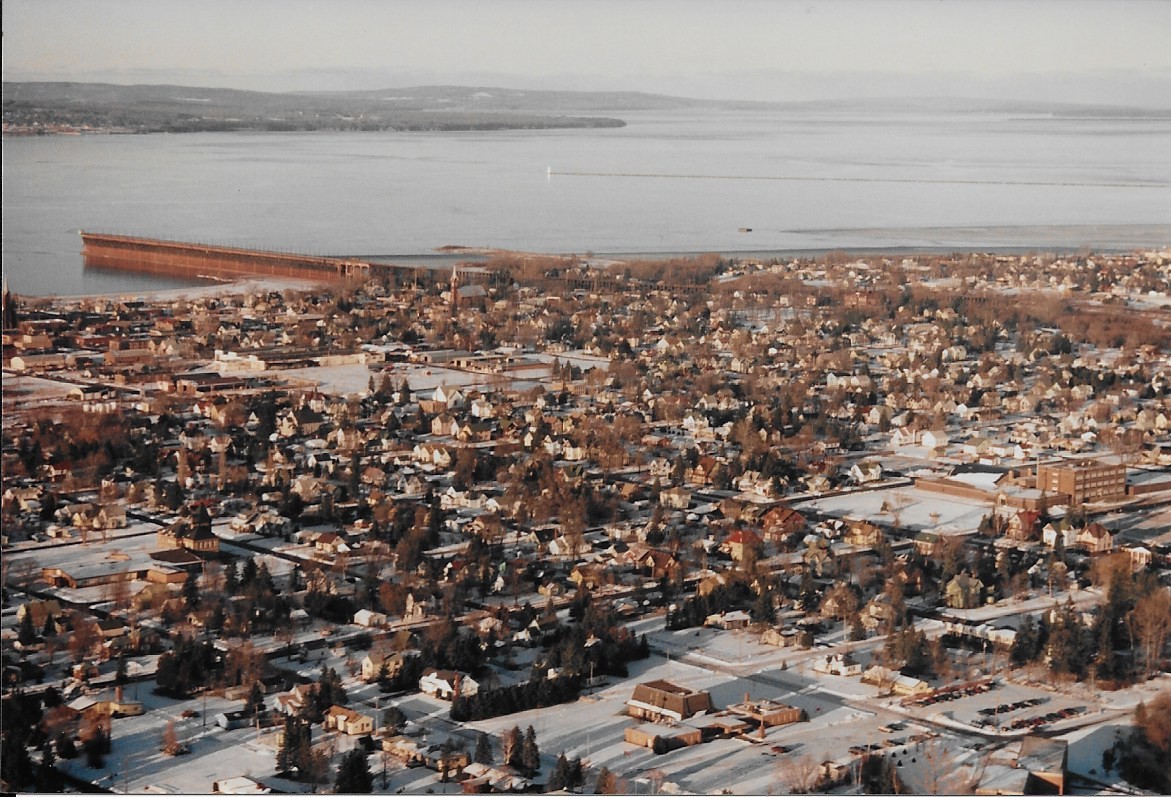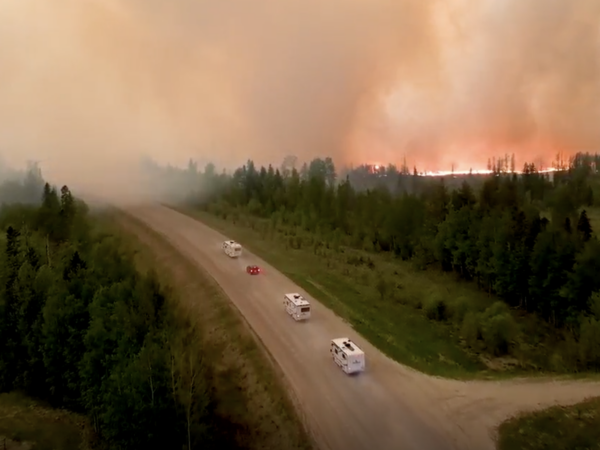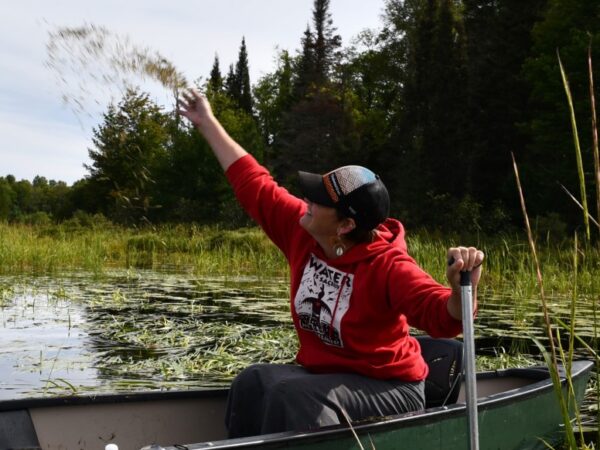Chequamegon Bay plays a significant role in our human lives, including past residents like the Huron and Ottawa; and current residents, the Ojibwe-Anishinaabeg, who have gathered and made history there for a millennia. An oblong, shallow bay (61 feet at the deepest point), on the south shore of Lake Superior, the water also holds dark history as a federal Superfund site. “Chequamegon” stems from a misinterpretation of zaagawaamikong-wiikwed — the Ojibwe word describing “a bay that is made by a long sand bar beneath the surface.”
The Bad River Ojibwe Nation is just east of Ashland, Wisconsin, a small city built on the bay. The Bad River community is located at the confluence of the Bad and White Rivers, an area originally known as “Gete Gititaaning, meaning “at the old garden.” This is in reference to the rich topsoil found there. This condition was created by the natural flood-based hydrology of the rivers that feed into Lake Superior. If you enter the town of Ashland from the west, Highway 2 takes you along the edge of the Kakagon Sloughs — a wetland area that contains manoomin beds and rare species of birds and plants. The Sloughs is one of the largest pristine freshwater wetland estuaries in the Midwest, and was designated as a National Natural Landmark in 1973.
The Mashkiiziibii (Bad River) and Miskwaabikaang (Red Cliff) Reservations were established by the 1854 Treaty of LaPointe, which was signed on Madeline Island, a place cited by Bad River as the “longtime capital and cultural/religious center of the Ojibwe Nation.” Bad River is the largest Ojibwe reservation in Wisconsin and Red Cliff is the smallest.

Chequamegon Bay early spring. (Photo Credit: Staci Lola Drouillard)
This area is water rich, and tribal activism has taken on special interests in many forms, including opposition to Line 5, a Canadian oil pipeline. In late January, the Trump administration reversed course on environmental regulation and environmental justice policies created by the Biden administration which required 40% of the benefits from certain environmental programs go to hard-hit communities. The administration also eliminated Federal Actions to Address Environmental Justice in Minority Populations and Low-Income Populations, passed by the Clinton administration in 1994. In February, Trump also announced significant cuts to the Superfund program headed by the EPA.
Chequamegon Bay is one of the Superfund Sites that has directly impacted tribal communities, with water pollution and soil contamination going back to the days before government environmental regulation. It’s a prime example of what can happen when regulations are absent. It’s also a lesson in temerity, and how long Superfund cleanup takes, in real time.
Here’s What Unregulated Industry Looks Like
Built in 1845, the Manufactured Gas Plant (MGP) operated 1,000 feet from Lake Superior in Ashland, Wisconsin. The company manufactured gas using coal, peat and other materials until the plant closed in 1947. The process created tar and tar-tainted water as by-products that were dumped into the bay or released on shore.
At the same site, the John Schroeder Lumber Company owned and operated a sawmill on the banks of Lake Superior from 1901 until 1939. The mill manufactured and treated various wood products with tars and other chemicals as sealants. The by-products were wood chips, saw dust and tar/creosote particulates. After the plant was closed, its title eventually passed to the City of Ashland, which built a wastewater treatment plant at the site. In addition, adjacent land nearby was used as a landfill from 1880 to 1951.
This compilation of unregulated industry resulted in the contamination of 28.5 acres, including 16 acres of polluted sediment in Chequamegon Bay. Contamination of soil and groundwater at the site was first confirmed in 1989, during exploratory work to expand the city water treatment plant. The city subsequently closed the plant, and built a new facility a few miles to the northeast.
According to EPA assessments at the time, “contaminants found in sediment, groundwater, soil and a buried ravine include tar, oil and other waste consisting of polyaromatic hydrocarbons, or PAHs, volatile organic compounds, or VOCs, and metals.” In summary, the EPA found that “Soil, groundwater, and an adjacent residential area are contaminated.”

Chequamegon Bay winter. (Photo Credit: Staci Lola Drouillard)
The EPA also determined that, “Because groundwater is contaminated at levels of health concern,” two artesian wells were closed as a precautionary measure. The agency also restricted access to a portion of the bay and shoreline, “because when sediment is agitated, oil and tar can be released causing a slick to form,” confirming that, “residual contaminants could cause skin irritation and increased sensitivity to the sun.” And that is just the human factor.
Despite the severity of results, it took until 1994 for a formal investigation by the EPA, and another six years for the site to be designated as a “National Priority” Superfund site. A remedial investigation conducted in 2001 identified these response actions:
- Removal and treatment or off-site disposal of contaminated soil, groundwater and sediment, including all NAPL (non aqueous phase liquid).
- Engineered surface and vertical barriers to contain contaminated groundwater.
- Groundwater extraction as hydraulic control and restoration and possible in-situ treatment of groundwater.
- Long-term groundwater and sediment monitoring.
- Institutional Controls (ICs) such as land use controls, to limit future use to prevent exposure to hazardous substances that will remain at the Site after the remedy is complete.
Litigating 169 Years of Pollution
In 1980, Congress established the Comprehensive Environmental Response, Compensation, and Liability Act (CERCLA), which is informally known as “Superfund.” This Act of Congress was in response to infamous hazardous waste sites such as Love Canal in New York. One of the primary goals of Superfund is to “make responsible parties pay for work performed at Superfund sites.”
The U.S. Department of Justice (DOJ) handles the litigation between the communities that suffer the environmental consequences of pollution, and the companies that created the hazard. Based on the law, Northern States Power was held primarily responsible for the cost of cleaning up Chequamegon Bay, at an estimated cost of $42 million dollars. That number was not determined until ten years after the EPA made their plan of remedial action. As over 100 years of pollution continued to permeate the soil and water, the tribal governments at Bad River and Red Cliff, the State of Wisconsin, Northern States Power (NSP) and the City of Ashland worked through the legal process.
In 2012, the U.S. District Court for the Western District of Wisconsin in Madison, Wisconsin, announced the settlement, which stated that, “Northern States Power will design, construct and implement the cleanup plan for the on-land portion of the site,” and that, “the United States will also require additional cleanup of sediments in Chequamegon Bay, and expects that Northern States Power and any other responsible parties will perform the rest of the cleanup.”

Aerial photo of the Ashland waterfront. (Photo Credit: Cathy Quinn, 1994)
As recompense for damages, the settlement also required NSP to transfer 990 acres of land along the Iron River to the Wisconsin Department of Natural Resources and return 400 acres of land located within the reservation, back to the Bad River Band of Ojibwe. In addition, the state of Wisconsin agreed to transfer 114 acres of land to the Red Cliff Band of Ojibwe.
The returned land, including the Iron River acreage, was given a net worth of “about $1.9 million.” According to the Indian Land Tenure Foundation, the acres promised in the settlement were transferred to the bands in accordance with the settlement. Other government agencies involved in litigation included the National Oceanic and Atmospheric Administration and the U.S. Fish and Wildlife Service, to “serve as trustees for natural resources in the area and joined the settlement on behalf of the United States.”
Note that actual cleanup of the site did not begin until 2014 — 169 years after the Manufactured Gas Plant dumped the first batch of wastewater into Chequamegon Bay. A permanent breakwater barrier was built in 2015 in the bay to control wave action, and cleanup efforts required utilizing a full-scale wet dredge of sediment in the bay. Cleanup actions were completed in 2019, and as required by law, long-term monitoring was scheduled in five-year intervals. The Chequamegon Bay site page has not yet posted the results of the 2024 monitoring report, nor has the site been marked as “deleted” by the EPA — a designation that occurs when no additional clean up or long-term monitoring is needed.
Signaling a departure from protecting people and the environment from pollution, the DOJ archive page that details the legal settlement reached in 2012 recently added a “Related Content” link. This takes you to a press release about the Trump administration’s “Unleashing American Energy” initiative, which prioritizes infrastructure like pipelines and oil and gas export facilities. Given that it took 174 years to clean up the mess made by a handful of extractive industry companies at Chequamegon Bay, this shift in priorities will have grave implications for the next three generations or more.
Featured image: Chequamegon Bay Madeline Island in distance. (Photo Credit: Staci Lola Drouillard)




